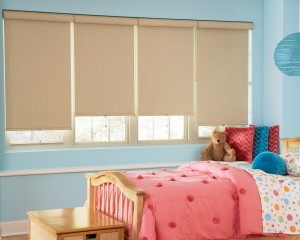Sometimes it seems like every cause has a month devoted to it. October, for example, is known as Pizza Month, Squirrel Awareness Month, and National Toilet Tank Repair Month, to name but a few. While some might find these causes amusing (especially those of us who are constantly chasing squirrels away from our bird feeders), October is also a month that draws attention to more serious issues, including at least one that is near and dear to our hearts: National Window Covering Safety Month.
 According to the U.S. Consumer Product Safety Commission, unsafe or dated window coverings are one of the top five hidden hazards in American homes. Corded window coverings, for example, cause the tragic deaths of infants and children each year by accidental strangulation.
According to the U.S. Consumer Product Safety Commission, unsafe or dated window coverings are one of the top five hidden hazards in American homes. Corded window coverings, for example, cause the tragic deaths of infants and children each year by accidental strangulation.
And it’s not just children who are in danger due to unsafe window coverings—household pets, senior citizens, and the general population can also be at risk. While improvements in industry safety standards have decreased the number of accidents, awareness is the best line of defense. That’s exactly why National Window Covering Safety Month was established.
To do our part, we’ve put together a list of features and tips that will ensure your window coverings are as safe as possible. Read them and share them, because you never know whose life you may save:
 When in doubt, go cordless. Thanks to the latest options in window coverings, you can completely avoid having a cord or tassel, drastically reducing the risks for small children and pets.
When in doubt, go cordless. Thanks to the latest options in window coverings, you can completely avoid having a cord or tassel, drastically reducing the risks for small children and pets.
Experts recommend using cordless blinds in homes with children eight years old and younger. Shutters are a safe and attractive alternative, and so are motorized shades, which can be opened and closed with the push of a button.
Practice cord safety. If you can’t avoid cords entirely, taking necessary precautions is essential. Make sure all tasseled pull cords are as short as possible, and check that all continuous-loop pull cords on drapes and blinds are pulled tight and anchored to the floor. You can also add safety features to existing cords. For example, spring-assisted clutches can be installed to raise and lower window coverings, and tassels can be upgraded to a break-away version, which are designed to snap apart under stress.
Rearrange your furniture. The Home Safety Council recommends placing all furniture, cribs, beds and climbable surfaces away from windows and their coverings. This helps keep window cords safely out of reach. It also lessens the chance that a child could accidentally fall out an open window, and protects them in case a window breaks. If placing a bed or crib near a window is unavoidable, add a window film to fortify the glass against risks such as hurricanes, a common occurrence in the Wilmington, NC area.
Special concerns for the elderly. Ensure that your elderly friends and relatives practice window safety, especially if they live alone. Check that windows are easy to open from the inside, but have secure locks to prevent intruders. Make sure the range or cooktop is not located under a window and, if it is, that there’s no risk of heat or flames singing the curtains. And finally, protect window wells with a bannister or railing, which will add a layer of defense between elderly occupants and glass windows in case of a fall.
 Pets need safety features, too! Many of the same rules for young children can also be applied to pets—avoid cords, tassels, and anything that might cause a pet to get stuck and panic. Pets might easily destroy mini-blinds, especially dogs who like to look out the window or give mail carriers a stern warning. For this reason, fabric shades, curtains, and drapes are a safer choice for homes with dogs.
Pets need safety features, too! Many of the same rules for young children can also be applied to pets—avoid cords, tassels, and anything that might cause a pet to get stuck and panic. Pets might easily destroy mini-blinds, especially dogs who like to look out the window or give mail carriers a stern warning. For this reason, fabric shades, curtains, and drapes are a safer choice for homes with dogs.
We hope this post has made you aware of the small steps you can take toward a safer home. If you’d like to discuss your options in greater detail, contact Strickland’s today, and we’ll create a protection plan precisely for your needs.